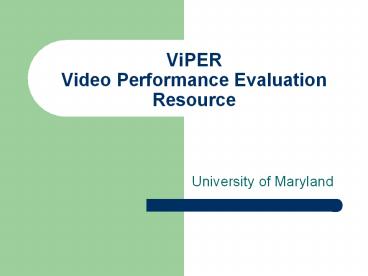ViPER Video Performance Evaluation Resource PowerPoint PPT Presentation
Title: ViPER Video Performance Evaluation Resource
1
ViPERVideo Performance Evaluation Resource
- University of Maryland
2
Problem and Motivation
- Unified video performance evaluation resource,
including - ViPER-GT a Java toolkit for marking up videos
with truth data. - ViPER-PE a command line tool for comparing
truth data to result data. - A set of scripts for running several sets of
results with different options and generating
graphs.
3
ViPER-GT
4
Data Format
- A series of items, each with a set of attributes.
- 3 Types
- File
- Content
- Object
- Allow the user to specify their own data.
- Let the performance evaluation tool handle the
mapping between different descriptor
configurations. - XML Format
- Allows for easier parsing and more exact
specification.
5
ViPER-PE
- Object level matching.
- First, do matching.
- For each ground truth object, get the output
object that is the closest. - Alternatively, for each subset of truth objects,
get the subset of output objects that minimizes
the total overall distance. - Measure of precision / recall for all objects.
- Score for each object match.
- Pixel/object frame level and single-match
tracking. - For each frame, generate a series of metrics
looking at the truth and result pixels and box
sets. - Using keys, or the location of object in frame k,
get success rates for matching individual moving
boxes.
6
Object Level Matching
- Most obvious solution many-many matching.
- Allows matching on any data type, at a price.
7
Pixel-Frame-Box Metrics
- Look at each frame and ask a specific question
about its contents. - Number of pixels correctly matched.
- Number of boxes that have some overlap.
- Or overlap greater than some threshold.
- How many boxes overlap a given box?
(Fragmentation) - Look at all frames and ask a question
- Number of frames correctly detected.
- Proper number of objects counted.
8
Pixel Metrics
- Examine the pixels that were detected, not the
objects
9
Pixel-Object Object Count
- How many objects were detected over the whole
clip? - The simplest metric, this does not take into
account any attribute data, just the object type.
10
Pixel-Object Detection
- Look at the number of result boxes that overlap
some truth object.
11
Pixel-Object Localization
- For each object that is detected, only count
those that have at least some accuracy in terms
of the number of shared pixels.
12
Pixel-Object Fragmentation
- A function of the number of result objects that
each truth object overlaps.
13
Frame Metrics
- How many frames that were correctly marked as
containing data? - What is the count accuracy for that frame?
Detected
1
2
2
1
Truth
Missed
1
4
4
False
Result
Ignored
Acc.
0
.6
.6
0
0
14
Individual Box Tracking Metrics
- Mostly useful for the retrieval problem, this
solution looks at pairs of ground truth boxes and
a result box. - Metrics are
- Position
- Size
- Orientation
15
Questions Ignoring Ground Truth
- Assume the evaluation routine is given a set of
objects to ignore (or rules for determining what
type of object to ignore). How does this effect
the output? - For pixel measures, just dont count pixels on
ignored regions. - For object matches, do the complete match when
finished, ignore result data that matches ignored
truth.
16
Tools
- RunEvaluation
- Runs multiple evaluations and creates graphs to
compare them. - gtf2xml, xml2gtf, gtf2gtf, xml2xml
- Allow conversion between data formats
- Allow merging of multiple data files
- Split and clip functions good for producing
starter data. - Installation scripts
17
Ground Truth
- Keyframe collection.
- Text
- Face
- Clip collection.
- Text tracking
18
Progress
- GT
- Polygons
- Interpolation
- Zoom scope
- PE
- Penn State metrics
- Improved data filtering
- Scripts
- Improved scripts for handling batch processing
- Manipulation of sets of ground truth data
19
Goals and Milestones
- Defining formats for tracking people, and metrics
to operate on them. - Adding new types of graphs to the script output.
- Replacing or upgrading the current graph toolkit.
20
-
- Dr. David Doermann
- David Mihalcik
- Ilya Makedon
- many others
21
Questions Presenting the Results
22
Questions Describing People

